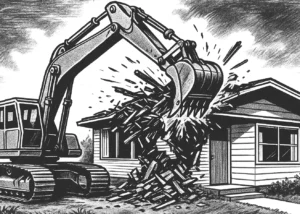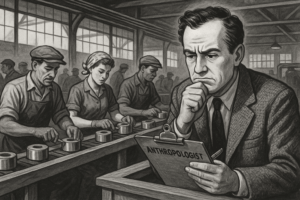I vaguely remember going through the Bacchus Marsh Avenue of Honour in Bacchus Marsh from childhood. We would pass through as we headed to Ballarat to see my grandparents. If we were lucky, we would go to Lion Safari Park. I remember looking up through the window at the tunnel of trees and the smell of the hot vinyl seats. It was a marker of a halfway point and a rest on our trip from the distant eastern suburbs of Melbourne. As an adult, Bacchus Marsh had been bypassed, and trips to Ballarat were no longer marketed by the Avenue. In 2010, my wife, kids and I uprooted from the leafy inner eastern suburbs for a peri-urban change. We ended up on the Avenue by accident, which triggered memories and a newfound appreciation of the trees. We stopped at Jeff and Glenda’s produce store along the Avenue. While sitting in the carpark crunching away on freshly picked apples, new memories and a new story began. Soon after, we moved to Bacchus Marsh temporarily; however, that quickly became permanent. Our relationship with the Avenue has grown and changed with our time here. Hearing about the ‘locals’ stories and ‘opinions’ also factor into the new relationship with the space.
When we first drove down the Avenue, I could not have imagined that I would become a member of the local heritage committee. During my time there, we were presented with plans to replant and manage the Avenue in the coming years. The plans were very systemic and functional, void of cultural consideration. That is why heritage committees are important. So, I have decided to look deeper at the Avenue and see what lies behind the cultural entanglements and personal stories.
Introduction
The Bacchus Marsh Avenue of Honour is a renowned living war memorial – a double row of towering elm trees lining the eastern entrance of Bacchus Marsh in Victoria. Planted in 1918 to commemorate local service personnel of World War I, this 2.8 km arboreal avenue now stands as a heritage-listed landmark of both natural beauty and historical importance. Today, the trees are over a century old; the Avenue has become deeply ingrained in the town’s identity and daily life, symbolising collective memory and community pride. However, the Avenue today faces significant challenges – from development pressures and pest infestations to the inexorable ageing of its trees – spurring concerted preservation efforts. This article provides a detailed overview of the Avenue’s origins and significance as a war memorial, examines the current threats endangering its future, and explores ongoing conservation initiatives. It also reflects on the broader cultural and anthropological dimensions of the Avenue of Honour, including its role in placemaking, embodied memory and identity, and connections to Australian First Nations concepts of memory and land.
Historical Overview and Memorial Origins
The Bacchus Marsh Avenue of Honour was established amid the closing months of World War I as a community-driven tribute to those who served. On 10 August 1918, more than a thousand residents gathered along the roadside near the Woolpack Inn for a grand planting ceremony. At the sound of a bugle, teams of volunteers simultaneously planted 281 young elm trees (a mix of Dutch elms and Huntington elms) in honour of local men and women involved in the war. The planting was accomplished within half an hour, a feat of extraordinary coordination that underscored the unity and solidarity of the town. Each tree was dedicated to an individual service person, originally marked by a timber guard and a copper name plaque listing the soldier’s details. In a deliberate show of egalitarianism, the plaques were arranged alphabetically rather than by rank or order of death. This meant that family members from the district who died overseas would be remembered side by side, and it reinforced the idea that every individual’s contribution was equally valued. Such inclusive design set the Bacchus Marsh memorial apart from many contemporaneous war monuments that typically honoured only the fallen – the Avenue acknowledged not only those who died but all who served, including returning veterans and those still in the field.
The Avenue quickly became a cherished symbol of remembrance and community. Historical records describe how local businesses closed on planting day and how women’s auxiliary groups provided refreshments for the crowds while families placed mementos – coins, uniform buttons, handwritten notes – into the soil with the tree roots, creating “literal and figurative foundations of memory” beneath each sapling. In the ensuing decades, as the elm trees matured into a grand allée, the site assumed a daily commemorative presence: a living monument that townsfolk would drive or walk through, integrating war memory into the landscape of everyday life. The full Avenue stretches almost 3 km and originally extended nearly to the Hopetoun River’s concrete bridge on the town’s edge (Avenue of Honour | Monument Australia). It is flanked by fertile farmland and orchards, so the memorial trees long intertwined with the rural vistas of Bacchus Marsh and its agricultural heritage.
Heritage and Significance
The Bacchus Marsh Avenue of Honour is recognised as one of Australia’s most significant memorial avenues. It is the second-largest Avenue of Honour in Victoria, and remarkably, it remains largely intact in its original form. Over 260 original WWI elms still stand, forming a continuous canopy. This high level of integrity and its historical importance led to the Avenue’s listing on the Victorian Heritage Register as a state cultural heritage significance site. The Avenue is part of a broader Australian tradition of Avenues of Honour – living memorials of trees planted to commemorate war service – a practice that began in Victoria’s goldfields region and saw over 500 avenues established nationwide after World War I. Even among these, Bacchus Marsh’s Avenue is often noted for its beauty and scale. It is sometimes described as “a magnificent honour-guard” of trees welcoming visitors into the township. Generations of residents have attached profound meaning to the elm-lined road. It serves as the site of ANZAC Day and Remembrance ceremonies. It has inspired local histories, artworks, and commemorative projects (such as the 2018 centenary “Resting Poppy” memorial installation by the Bacchus Marsh RSL). After more than 105 years, the Avenue endures as a tribute to the sacrifices of war and as a defining feature of Bacchus Marsh’s identity and heritage.
Threats and Challenges to the Avenue
Despite its honoured status, the Avenue of Honour faces multiple threats that jeopardise its health, integrity and legacy. Chief among these are encroaching road development, biological pest infestations, and the aging and senescence of the trees themselves. Each of these factors has prompted concern from experts and the community, as well as interventions aimed at safeguarding the Avenue for future generations.
Road Development Pressures
From the late 2000s onwards, proposals to upgrade roads and manage growing traffic in Bacchus Marsh have threatened the Avenue’s fabric. The most contentious plan was a state proposal to construct a large roundabout and extend Woolpack Road to meet the Western Freeway – effectively bisecting the Avenue of Honour. In 2010, VicRoads (the state roads authority) unveiled plans for this intersection that would have required the removal of between 8 to 12 of the heritage elm trees. The justification was to reduce congestion and improve safety on the existing highway route through the town. However, residents, the Bacchus Marsh RSL, and heritage advocates rapidly mobilised in opposition.
An Avenue Preservation Group was formed in 2009 and campaigned vigorously to “save the Avenue” from incursion. In 2010–2011, the dispute went before Heritage Victoria, which refused permits for the roadworks on the grounds of unacceptable impact on a protected memorial. By January 2012, the Victorian Planning Minister Matthew Guy upheld the heritage objections. He formally blocked the roundabout project, affirming that “the continuous and uninterrupted nature of this significant cultural heritage landmark” must be ensured. This decision was celebrated by the local community and the National Trust, who had jointly fought the proposal.
Although that particular threat was averted, traffic pressures in the region have not abated. Planning authorities have since investigated alternative bypass routes around Bacchus Marsh, including an Eastern Link Road to divert heavy vehicles. Several route options were explored, and as of 2019, three out of four proposed corridors would still cut through the Avenue of Honour, again raising heritage and environmental alarms. Community feedback in public consultations strongly favoured options that preserved the Avenue, even if they had other impacts. In response, authorities indicated they would strive to find a “balanced” solution, acknowledging the Avenue as a “complexity” requiring careful consideration in any design. Indeed, government ministers have noted that local sentiment showed “strong support … for the preservation of cultural heritage” over expedient roadworks.
As of the mid-2020s, the Avenue remains intact, and no road extension has been built through it, but development pressure is an ongoing concern. Any future infrastructure project must reconcile the town’s transport needs with the non-negotiable imperative to protect a sacred landscape. The prolonged saga has underscored how deeply the community values the Avenue – it is not merely a strip of roadside trees but a revered memorial that residents staunchly defend. As one Avenue Preservation Group member put it during the conflict, “In the end it seems to be that roads dictate decisions for governments,” voicing frustration that utilitarian interests might trump historical sanctity (Vic Govt to decide Avenue of Honour project – ABC News). So far, citizen advocacy and heritage laws have successfully held the line against such incursions.
Elm Beetle Infestations and Disease
Another serious threat comes from biological pests and diseases affecting the elm trees. The Avenue’s elms (Ulmus ×hollandica) are now over a century old and have been persistently attacked by the Elm Leaf Beetle (Xanthogaleruca luteola), an introduced pest in Australia (). Elm leaf beetle larvae and adults feed voraciously on elm foliage, “skeletonising” the leaves and causing defoliation that weakens the trees over successive seasons.In Bacchus Marsh, sustained infestations have been recorded in recent decades, leaving many trees ragged in summer and reducing their vitality. The mature elms, already under stress from age, have “reduced resilience and shorter life spans” partly due to this chronic pest pressure. Moorabool Shire Council has an active management program to control elm leaf beetles on the Avenue. This includes regular monitoring and treatment – often by trunk injection or canopy spraying of insecticides – to keep populations at bay.
Without such intervention, an unchecked beetle outbreak could defoliate the entire Avenue and potentially kill trees, as repeated defoliation severely depletes the trees’ energy reserves. In addition to the leaf beetle, the Elm Bark Beetle (present in Australia) is closely watched by biosecurity authorities because it can carry the fungus causing Dutch Elm Disease (DED). DED has devastated elm populations in Europe and North America but, fortunately, has not reached Australia to date. Given that the Bacchus Marsh elms are all of a species highly susceptible to DED, an incursion of that pathogen would be catastrophic. As a precaution, council arborists and state authorities maintain vigilance; any suspicious wilting or dieback is investigated, and protocols are in place for immediate containment should DED ever be detected.
Therefore, the health of the Avenue’s trees is a matter of continuous attention. In recent years, advanced techniques have been employed to aid in early detection of problems. For example, acoustic tomography (a kind of ultrasound for trees) is used to scan for internal rot or structural weakness without harming the trunks. Soil testing and leaf tissue analysis are also carried out to monitor nutrient levels and tree metabolism, ensuring pest damage or stress can be spotted and managed proactively. The elm trees of the Avenue are living organisms that require care, much like patients in a long-term health program; pest control and disease prevention have thus become integral to preserving this living memorial.
Ageing and Environmental Stress
Time itself is an ever-present threat to the Avenue of Honour. The original elms, planted over 105 years ago, are now reaching the natural lifespan limits for this species. As senescent trees, many have developed heartwood decay, hollow limbs, or other structural issues common in old age. Branch drop has become a noted hazard – locals recount dramatic incidents of large limbs cracking off during storms, anecdotally described as “exploding branches” that have made some residents wary of driving the Avenue in wild weather. In a few cases, trees have died or become dangerously unstable and had to be removed. A thorough arboricultural assessment in recent years found many elms in poor condition or decline.
In 2023, Moorabool Shire adopted a Preservation Plan that identified 255 trees that would likely need replacement within 20 years (out of the total 360 trees along the roadway, which includes the 281 commemorative elms and later plantings). This phased removal is aimed at “staging loss in the canopy” – i.e. avoiding a scenario where most trees fail at once – and prioritises those with advanced decay or incorrect species (there are a few non-elm intruder trees). The Plan schedules about 30 removals/replacements in the first 2–3 years (2023–2025) and spreads the remainder over two decades. Inevitably, the Avenue’s landscape will slowly transition as old trees are removed and young replacements grow. However, the goal is to maintain the continuity of the Avenue’s form and character.
Environmental stresses such as climate change and urbanisation complement the challenges of age. The elms, originally a European species, are now experiencing hotter and drier conditions than a century ago. Recent data indicates that average summer temperatures in the Bacchus Marsh area have risen by nearly 2 °C since the 1950s, and drought cycles have intensified. During the Millennium Drought of 1996–2010, many Avenue trees suffered moisture stress, and local volunteers initiated emergency watering efforts – with residents “adopting” individual trees to hand-water in dry months. The community’s involvement likely saved numerous trees during that period. Storm frequency and wind intensity also appear to be increasing, which, as noted, can be destructive for ageing elms. Additionally, the effects of urban development around the Avenue (though the road is still semi-rural) include heavier traffic vibration, soil compaction at the roots, and air pollution from vehicle exhaust.
Since the 1980s, traffic volume on that road has reportedly quadrupled, contributing to root zone stress and mechanical damage risk from collisions. These factors further weaken old trees. The local council has tried to mitigate such impacts by imposing lower speed limits, adding protective barriers, and rerouting large trucks via other new roads (e.g. the Halletts Way bypass opened in 2014). Nevertheless, the aging of the Avenue is unavoidable, and with each passing decade, a more significant proportion of the original trees will likely succumb. The challenge is ensuring that as individual elms die off, the Avenue as an entity – its linear form, canopy, and memorial function – survives through a new generation of trees.
Conservation and Preservation Efforts
Managing the Avenue of Honour long-term requires a delicate balance between historical fidelity, horticultural science, and community engagement. In recent years, significant efforts have been made to conserve the Avenue’s heritage while renewing it sustainably. Key strategies include propagating new elm trees from the original stock, careful maintenance and monitoring regimes, and inclusive planning involving experts and local stakeholders.
Propagation and Tree Replacement Program:
One of the most innovative conservation measures has been the decision to propagate replacement elm trees from cuttings (budwood) taken from the existing Avenue trees. This initiative ensures that any new trees planted are genetically “true to type” and maintain a direct lineage to the 1918 originals. According to the Bacchus Marsh Avenue Preservation Plan (2023), cuttings from selected healthy parent trees (chosen in consultation with Heritage Victoria for their vigour and form) are grafted onto rootstocks and grown in nursery conditions for 3–4 years to produce saplings of planting size. By using this cloning method, the continuity of the Avenue’s botanical character is preserved – the two specific cultivars of Ulmus ×hollandica that make up the Avenue (the common Dutch elm and the narrower ‘Huntington’ elm) will continue to dominate the replanted sections.
This is crucial for keeping the uniform look of the Avenue: the Dutch and Huntington elms have distinctive shapes that together create the interlocking canopy. If random different species were used, the aesthetic and symbolic unity of the memorial would be disrupted. The propagation program, led by specialist arborists and local nurseries (notably in partnership with a respected regional nursery, Fleming’s Nurseries), is already well underway. Fleming’s has reported working to preserve the Avenue “as true to its original form as possible by propagating from the original trees and replanting” from that stock. Hundreds of grafted elm saplings are being prepared, effectively a living archive of clones that will replace aging trees incrementally. The community has strongly supported this approach – even as the loss of an old tree saddens people, they take comfort in knowing its “offspring” will carry on the legacy on the same soil.
The RSL sub-branch and local historical society have also backed the plan, seeing it as a way to “maintain the Avenue’s lineage” and honour into the future. With an estimated 20-year horizon for complete renewal, this replanting programme represents a commitment to keep the memorial trees on the Avenue in perpetuity, effectively future-proofing the memorial while respecting its past.
Maintenance, Monitoring and Protection
Alongside replanting efforts, there is a robust maintenance regime to care for the existing trees. Moorabool Shire Council’s management strategy calls for routine arboricultural assessments – at least annually – to check each elm’s health, stability, and treatment needs. Deadwood is pruned to reduce the hazards, and where possible, interventions like cabling of weak branches or treatment of fungal infections are done to prolong the life of veteran trees. As mentioned, the council employs or contracts professional arborists who utilise modern technology. For example, seismograph drilling and acoustic tomography are used on suspect trunks to map internal decay and decide if a tree can be retained safely.
The soil around each tree is also managed – compaction from the popular roadside produce stalls and soil aeration techniques alleviate parking. Mulch is applied to improve root moisture retention. An active Elm Leaf Beetle control program is in place (typically involving systemic insecticide injections every few years) to prevent defoliation damage. Crucially, the Avenue’s status on the Victorian Heritage Register provides a layer of legal protection: any works that might affect the trees (from roadworks to utility trenching) require heritage permits and careful oversight. This has prompted authorities to use unique methods; for instance, when installing underground services near the Avenue, they must use non-invasive boring techniques at a safe depth to avoid cutting through roots.
The community remains closely involved in stewardship as well. Local volunteers often assist in watering young replacement trees and promptly report any visible issues (like pest outbreaks or vandalism) to the council. The sense of collective ownership that began on that planting day in 1918 continues: The Avenue is cared for not just by bureaucrats but by the people for whom it holds meaning.
Memory, Identity and Placemaking in the Avenue
Beyond its physical attributes and maintenance, the Bacchus Marsh Avenue of Honour holds profound cultural and anthropological significance. It is a site where history, memory, identity, and place are deeply interwoven. Over time, the Avenue has transcended its original function as a war memorial to become an integral part of the community’s social fabric and sense of place. In scholarly terms, it can be viewed as a “lieu de mémoire” – a site of memory – where collective remembrance is anchored in the landscape. Unlike a static monument of stone, this living memorial engages people through all the senses and through time, embodying what anthropologists call “emplaced memory,” the phenomenon of memory residing in physical settings and our bodily experience of them.
Community Identity and Embodied Memory
For the people of Bacchus Marsh, the Avenue is not just a memorial to past soldiers but a defining feature of their town’s identity and daily life. Many residents have known the Avenue since childhood and have layered their memories onto it – from family drives under the green canopy to seasonal changes marking the years to stories of dramatic weather events. Longtime locals often give directions or describe locations about the Avenue, reflecting how it serves as an orienting backbone of the district. The trees themselves have become almost like community members or guardians. There is local folklore about certain “personalities” of trees, and as mentioned, tales of near-misses with falling branches have become lore passed between generations.
Residents develop an intimate, sensory knowledge of the Avenue. One observer noted that “these trees integrate into everyday community life, while traditional monuments typically remain separate”. People experience the memorial by moving through it – walking, cycling, driving – thus, physical engagement continually activates memory. An illustrative anecdote comes from a resident, who said her grandmother could point out the specific tree that commemorates her great-uncle “not because she read the plaque, but because she recognises the distinctive bend in the trunk [and] the particular way light filters through those branches in autumn”. This captures how the Avenue’s meaning is stored in archives or inscriptions and in residents’ bodily and sensory familiarity with each tree. Such embodied memory – sometimes termed “kinaesthetic knowledge” – means the community remembers its history in a highly place-bound, experiential manner. The Avenue is effectively an open-air museum and sanctuary of memory that one lives within, rather than visiting only on occasion.
Furthermore, the Avenue plays a decisive placemaking role. It contributes to what geographers call the “sense of place” of Bacchus Marsh – the unique character and emotional resonance that distinguish the town. The tunnel of elms is instantly recognisable and has become a symbol for the area used in tourism brochures and local business names. It also shapes the approach to town, creating a feeling for visitors entering a unique, storied place. Community events have reinforced this: for the Avenue’s 100th anniversary in 2018, residents marched down the road and held ceremonies under the trees to mark the centenary. Such rituals strengthen communal bonds and attachment to the physical space. Sociologically, the Avenue helps maintain “cultural continuity” by linking current generations with those of the past through a tangible, living medium. The continuity is symbolic and literal – descendants of the original planters can walk the same route and care for the same trees (or their clones) that their forebears planted, making the act of remembrance a multigenerational communal project.
Notably, the usage of the Avenue is not confined to formal remembrance; it is also an everyday communal space. Children play and climb on the lower limbs (where safe), couples take wedding photos beneath the arching boughs, and elderly citizens find shade under them on hot days. These ordinary activities imbue the Avenue with living significance beyond its official memorial function. In the words of French scholar Michel de Certeau, the community’s daily interactions here can be seen as “spatial tactics” – ways in which people informally appropriate and give meaning to a commemorative space through routine practices. Thus, the Avenue’s cultural value is continuously reproduced and reinterpreted in the present, not just preserved as a static historic relic.
First Nations Perspectives – Memory and Connection to Land
While the Avenue of Honour is a product of settler-Australian war commemoration, it exists within a landscape with much older memory and meaning layers. The area around Bacchus Marsh is the Country of the Wurundjeri Woi Wurrung and Wadawurrung peoples, who for millennia have maintained their traditions of honouring and remembering through connection to place. In Australian First Nations cultures, the land is often viewed as a living archive of history, spirituality, and identity. A famous quote by Indigenous elder Bill Neidjie articulates this worldview: “Our story is in the land … it is written in those sacred places. … My spirit has gone back to my country”. In other words, memory for First Nations peoples is profoundly embedded in the landscape, inseparable from it. Sacred sites, songlines, and place names encode ancestors’ deeds and keep the past alive in the present.
Although the Avenue of Honour was not created with Indigenous principles in mind, it is striking that it, too, represents the embedding of human memory in the environment – the idea that the landscape itself can hold and transmit memory. In a sense, the Avenue’s elm trees have become storytellers of the community’s war history, much as a rock formation or river might carry the “story” of a Dreaming ancestor in Aboriginal culture. Scholars have noted This parallel by observing how Western war memorial practices, like tree avenues, inadvertently echo ancient practices of ritualising landscape.
The Avenue is also a reminder that the land has seen layers of conflict and service beyond the World Wars commemorated – including the frontier conflicts and service of Aboriginal people (some of whom also served in the World Wars but were not always officially acknowledged). In recent times, there have been moves to broaden the narrative of memorial avenues to include Indigenous perspectives, recognising that for Aboriginal Australians, remembrance and connection to land are deeply intertwined concepts. The Moorabool Shire’s heritage documents begin with acknowledgments of the Traditional Owners and note that places like the Avenue contribute to a landscape that holds meaning for Indigenous and non-Indigenous communities.
Moorabool Shire has a poor record of acknowledging the First Nations’ place in the area; that is another story for another day.
This reflective approach enriches the interpretation of the Avenue: It can be seen not only as a colonial memorial for 20th-century events but as part of a continuum of how humans invest meaning in “Country”. The Avenue’s trees may be exotic species planted by newcomers. However, over a century, they have been accepted into the land and now provide habitat for native birds and possums, effectively becoming part of the ecosystem. In this way, the Avenue is a meeting point of cultural memory and natural landscape.
Heritage conservationists have even described the Avenue as a place where “cultural heritage and natural processes are inseparable”, urging a holistic view that bridges the nature/culture divide. Such an integrated perspective resonates with Indigenous holistic views of land, albeit in a different cultural register. It highlights a fundamental point: Memory in place is a universal human experience, whether war memory in elm trees or ancestral memory in a sacred site. Both demand respect for the land that bears those memories.
Conclusion
The Avenue of Honour in Bacchus Marsh is a powerful testament to how a community can inscribe its history, values, and identity into the landscape. From its origins in 1918 as a bold act of collective remembrance – rows of young elms planted in unison to honour the sacrifices of war – it has grown into a venerable corridor of memory that touches nearly all aspects of local life. The Avenue’s significance is manifold: it is a war memorial, an ecological habitat, a heritage landmark, and a social space of continuity between generations. This dual nature as a cultural artefact and a living organism makes its preservation a complex but worthwhile endeavour. The current threats of road expansion, pests and disease, and natural aging have galvanised experts and citizens to take action, whether through legal protections, scientific tree care, or creative horticultural solutions like cloning the original trees.
These efforts reflect a recognition that the loss of the Avenue would be irreplaceable – not just a loss of beautiful trees, but a loss of collective memory and identity. As the Planning Minister’s decision in 2012 affirmed, maintaining the “continuous and uninterrupted” form of the Avenue is critical to preserving its cultural heritage value. Looking ahead, the Bacchus Marsh Avenue of Honour story is one of stewardship and adaptation. Its guardians are effectively writing a new chapter of remembrance that balances change and continuity: new saplings will replace old giants, even as the spirit and significance of the Avenue remain constant. In doing so, they ensure that this living memorial – born of community solidarity in the aftermath of war – will continue to thrive, linking past, present and future in the enduring shelter of its green canopy.
Sources:
- Bacchus Marsh Avenue of Honour – Moorabool Shire Council Heritage and Preservation Plan () (); Victorian Heritage Database (Virtual War Memorial | Bacchus Marsh Avenue of Honour, Bacchus Marsh,) (Virtual War Memorial | Bacchus Marsh Avenue of Honour, Bacchus Marsh,)
- “Avenue of Honour (Bacchus Marsh)” – Monument Australia (2013) (Avenue of Honour | Monument Australia); Virtual War Memorial Australia (Virtual War Memorial | Bacchus Marsh Avenue of Honour, Bacchus Marsh,) (Virtual War Memorial | Bacchus Marsh Avenue of Honour, Bacchus Marsh,)
- Adam Dimech, “An Avenue to Dishonour” – The Grapevine Blog (2010) ( An Avenue to Dishonour | The Grapevine) ( An Avenue to Dishonour | The Grapevine)
- “Vic Govt to decide Avenue of Honour project” – ABC News (11 April 2011) (Vic Govt to decide Avenue of Honour project – ABC News) (Vic Govt to decide Avenue of Honour project – ABC News)
- “High cost for new Bacchus Marsh traffic plan” – Melton & Moorabool Star Weekly (5 March 2012) (High cost for new Bacchus Marsh traffic plan | Melton & Moorabool)
- National Trust (Vic), Trust Advocate – “Bacchus Marsh Avenue of Honour” (March 2013) (Bacchus Marsh Avenue of Honour | Trust Advocate) (Bacchus Marsh Avenue of Honour | Trust Advocate)
- Aileen Moreton-Robinson, ABC Religion & Ethics – “Our story is in the land” (9 November 2020), quoting Bill Neidjie (“Our story is in the land”: Why the Indigenous sense of belonging unsettles white Australia – ABC Religion & Ethics).




